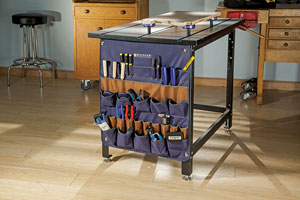
“I’m a woodworker.” That’s my answer when someone asks me what I do; “I make things out of wood.” Often their response is, “Oh, you do cabinets and make furniture?” I explain that I built my dining table and chairs and the buffet, the rocking chair and a houseful of furniture, but now I mostly do smaller things.
Often the person is confused; “If you don’t make furniture, then what do you make?” I tell them I use my lathe to turn candlesticks and stoppers and bowls. I carve spoons and kitchen gadgets out of walnut and maple. I use beautiful veneers to make marquetry pictures. And I use these techniques when I build things.
Being able to do marquetry, carving, turning and pyrography in addition to regular woodworking — you know, with the table saw, router and band saw — enables me to be more artistic, to add that nice little flourish to a project. I don’t incorporate all these disciplines into every piece — but during the planning, I consider whether carving or inlay or a turned part will enhance the project and, if needed, I’m ready with the skill, the tools and the materials.
 I’ve met woodworkers who focus narrowly on only one aspect of woodworking and shun all others; for example, they wouldn’t have a lathe in their shop if one were given to them. The same with veneer — a piece of furniture is cheap if it isn’t made from solid wood; they forget the work of the French and Italian masters. They wouldn’t think of adding a carved decoration to a piece of furniture, again forgetting Hepplewhite and Chippendale. Great furniture makers have always used veneers and carvings and turnings to great advantage.
I’ve met woodworkers who focus narrowly on only one aspect of woodworking and shun all others; for example, they wouldn’t have a lathe in their shop if one were given to them. The same with veneer — a piece of furniture is cheap if it isn’t made from solid wood; they forget the work of the French and Italian masters. They wouldn’t think of adding a carved decoration to a piece of furniture, again forgetting Hepplewhite and Chippendale. Great furniture makers have always used veneers and carvings and turnings to great advantage.
My advice to beginners is to join every woodworking group possible; learn everything you can about all crafts pertaining to wood. When you are planning a project — think about all these techniques. Then when you make your piece, it will be different and personal — uniquely yours.
-Ken Horner





